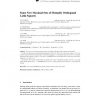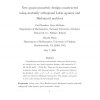45 search results - page 5 / 9 » On Non-Polynomial Latin Squares |
DCC
2003
IEEE
14 years 7 months ago
2003
IEEE
Two ways of constructing maximal sets of mutually orthogonal Latin squares are presented. The first construction uses maximal partial spreads in PG(3, 4)\ PG(3, 2) with r lines, wh...
DCC
2006
IEEE
14 years 7 months ago
2006
IEEE
Using Hadamard matrices and mutually orthogonal Latin squares, we construct two new quasi-symmetric designs, with parameters 2 (66, 30, 29) and 2 - (78, 36, 30). These are the fir...
SODA
2003
ACM
13 years 8 months ago
2003
ACM
Previous work on the partial Latin square extension (PLSE) problem resulted in a 2-approximation algorithm based on the LP relaxation of a three-dimensional assignment IP formulat...
ENDM
2006
13 years 7 months ago
2006
Greedy algorithm sometimes uses more than (G) colors while coloring a graph G. A greedy defining set is an object to eliminate these extra colors so that the greedy coloring resul...
DMTCS
2007
13 years 7 months ago
2007
We define a morphism based upon a Latin square that generalizes the Thue-Morse morphism. We prove that fixed points of this morphism are overlap-free sequences, generalizing resu...


